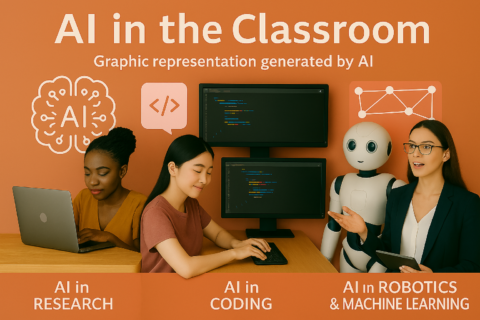The South African Schools Collection PR
Beyond The screen: Integrating Computational Thinking Across Learning
By Jil Hrdliczka
While the implementation of Coding and Robotics as a subject may be stalled for the moment, our students’ learning in this area can continue. Important skills can be integrated into computer classes and other learning areas, with or without devices.
One of these important skills is computational thinking. It integrates naturally into all learning areas. It’s easy to teach, widely understood by students, and deeply rewarding for our teachers.
The coding and robotics curriculum pause invites us to reimagine how we nurture problem-solving, creativity, and logic across the other learning areas. What if computational thinking could be taught through storytelling, art, or even in play or sport?
Though rooted in computer science, computational thinking which means breaking down a problem in small manageable parts; spotting patterns, symmetry, similarities and differences: ignoring what is not important for the moment, writing a step-by-step plan; testing and fixing any errors in the plan can be applied to all learning areas from literature to robotics to art and sport. It is a universal way of thinking that students of all ages can use in everyday life.
Knowledge Network uses computational thinking in coding and robotics as well as in all the other work completed by teachers and Quads Grade 0000 to Grade 12 students during their technology integration programmes. Varsity students who find themselves at a loss without computer skills at school level can join Knowledge Network programmes for research and referencing during which they too are unknowingly exposed to computational thinking.
Computational thinking is a thinking approach that both humans and computers can understand. It translates complex problems into logical steps that can be followed, executed or programmed by either human or computer, or AI.
The duality is what makes computational thinking so powerful in education. It is not about thinking like a computer, it is about thinking clearly enough so that a computer can follow your logic, and another person could too. Students learn to communicate ideas clearly whether to classmates, teachers, exam assessor or machines. Students build transferable skills like logical reasoning, sequencing and debugging. These skills are just as useful in writing essays, poems, songs, answering exam questions as they are in writing code for robots.
Global curricula define computational thinking as four core pillars: decomposition, pattern recognition, abstraction and algorithmic thinking. These pillars are widely recognised across education systems like SA, UK, Australia, New Zealand, Finland and the US.
Across the world computational thinking can be done without students seated in front of a computer screen. Knowledge Network’s All about Turtles Learning Computational Thinking Series for Foundation Phase includes indoor, outdoor and digital work. Young students learning robotics need to spend time outside – many robots and automated machines are outside – boom gates for one. Further, young students need to spend time learning in a 3D space, in the open, with fresh air, colours and exposure to environmental factors.
The digital part of the Knowledge Network turtle series can be done with devices or via data projector, smartboard or left out. Inclusion is better for students to link what they are learning outdoor and indoor to machines which also excites them and provides additional purpose. In addition, it serves to teach them care and respect in handling equipment in preparation for a time when they will handle expensive school robotic devices. Teachers can attend live, interactive zoom training from their computers anywhere in the country.
Knowledge Network includes a 5th pillar in all their technology integration programmes, with or without equipment. Debugging is vital across all learning areas because it teaches students how to identify mistakes, reflect on their progress and improve outcomes. This builds resilience, precision, problem-solving skills that apply far beyond coding.
Debugging is the process of identifying errors or unexpected outcomes, analysing why they occurred, testing and refining solutions. While this process is associated with programming, its principles apply universally, from editing an advertising flyer to correcting colours in a drawing, or fixing a formula in a spreadsheet, or correcting rainfall data capture at eco schools or adjusting a sports strategy.
Why is Knowledge Network’s 5th pillar so powerful? By elevating debugging as a pillar alongside decomposition, pattern recognition, abstraction and algorithms, Knowledge Network affirms that learning is iterative. Learning is progressive, understanding grows through cycles, it is not a one-time event. Students need to embrace mistakes as part of growth, they need to develop confidence in problem-solving, they need to learn to trust their instincts, their inner voice, they need to be able to transfer skills across different learning areas and into everyday life.
Debugging fosters critical thinking and resilience. Students learn to see mistakes as learning opportunities not failures. Students need to reflect on their own thinking and strategies. This applies equally to Grade 0000 and varsity students. Debugging strengthens student learning is all areas. In literature students revise drafts, in sport students analyse poor coordination, in costing students check calculations, in drawing students adjust colours, perspectives or proportions, in coding students test code for error handling, and in exams students check and edit their answers. In robotics, debugging during the coding process reduces risk and promotes student and equipment safety.
In 2025 Term 03 and Term 04, technology integration specialist teachers at Knowledge Network’s technology integration partner schools completed the All about Turtles Learning Computational Thinking series. Foundation phase students cut out and assemble paper turtles, colour them in, work out paths for them on indoor and outdoor grids and code digital turtles. These students apply their computational thinking skills to tracing, colouring in and drawing of characters in a coded story or writing the story.
Computational thinking is not about thinking like a computer, it is about thinking clearly enough that a computer, another person, or AI, can follow your logic. It is a critical, future-ready skill. With trained teachers, it can be seamlessly implemented in any school, anywhere in the world, at any time.

We asked AI Copilot to draw a real cat and then to use computational thinking to draw a computational thinking cat – break down the task into small parts, spot patterns, symmetry, shapes, ignore what is not important for now, use algorithmic thinking to write a step-by-step plan anyone can follow, spot and fix errors in the design or instructions just like a student would when something does not turn out as expected, which is often the case.
Below are 3D drawings by students completed on creating designs for 3D printing. These drawings clearly show the result of computational thinking with each drawing scoring 9/10 or more for computational thinking
- Decomposition: breaking down the animal into parts
- Pattern recognition: symmetry and shape repetition
- Abstraction: ignoring detail that is not important for now
- Algorithmic thinking: logical step-by-step approach
- Debugging: evaluating 3D viability and clarity

Computational thinking 3D cat, turtle, reindeer and dino by Grade 05 students from different schools in South Africa





